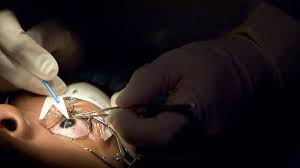Do you want to know how much power Lasik can correct? Lasik can provide a dramatic change for many people and it has become one of the most popular surgeries in the world. It is a safe and effective procedure that can correct many different types of vision problems, but there are some things you should know about Lasik before you decide if it is the right choice for you.
Contents
- 1 What is Lasik?
- 2 How Much Can Power Lasik Correct?
- 3 Pros and Cons of Lasik Surgery
- 4 How Does the Laser Work?
- 5 Can The Eye Still Be Injured With Lasik Surgery?
- 6 Does Lasik Work on Astigmatism?
- 7 What Are The Complications of Lasik Surgery?
- 8 Can Power Be Corrected With Lasik?
- 9 Can LASIK be Done for 10 Power?
- 10 Can Poor Vision Return After Lasik?
- 11 What Eye Problems Lasik Cannot Fix?
- 12 Conclusion
What is Lasik?

Lasik, also known as laser eye surgery, is a popular and effective procedure used to correct vision. Lasik uses a surgical blade called a laser to remove the thin layer of tissue that covers the eyeball. The surgery can correct mild to moderate myopia (nearsightedness), hyperopia (farsightedness), and astigmatism.
How Much Can Power Lasik Correct?
Power Lasik correct procedures are only effective for patients with a certain range of prescriptions. Eye Surgery Center currently accepts patients with nearsightedness up to -11.00 diopters, farsightedness up to +5.00 diopters, and astigmatism up to 5 diopters. All other patients must have a LASIK procedure conducted by an expert in the field in order to be considered.
The average patient’s uncorrected vision is about 20/40. After LASIK, the average patient’s corrected vision is about 20/20. This means that a patient with a 20/40 uncorrected vision after LASIK sees objects at a distance of 20 feet approximately equal to what they could see with a normal visual acuity of 40/20.
Pros and Cons of Lasik Surgery
There are many positive aspects to Lasik surgery, but it is not without its risks. Here are some of the pros and cons of Lasik surgery.
Pros of Lasik Surgery:
1. Lasik can correct vision problems that range from nearsightedness to farsightedness.
2. Lasik can help people with moderate to severe astigmatism.
3. Lasik can improve overall vision by correcting distortion caused by myopia (nearsightedness), hyperopia (farsightedness), and presbyopia (aging eyesight).
4. People who have had Lasik surgery typically report better vision than before the procedure, even if their initial correction is only modest.
5. With ongoing care, most people see excellent results with Lasik, achieving 20/20 or better vision in most cases after a single treatment session.
6. There is very little danger or discomfort associated with Lasik surgery, making it a safe and easy procedure for many people. In fact, most patients feel much better after their Lasik procedure than they did before it began!
7. The cost of Lasik varies depending on the type of laser used and the complexity of the patient’s case, but generally speaking, it is one of the least expensive ways to improve your vision quality.
8. There are no long-term side effects associated with Lasik surgery that have been documented in research studies to date. Some people experience minor visual
How Does the Laser Work?
Laser surgery uses a powerful laser to remove hair, wrinkles, and other surface irregularities from the eyes. Lasik surgery is one of the most popular forms of eye surgery in the world. The laser heats up the cornea, or the front surface of the eye, causing it to change shape and blur. This creates the desired effect on the underlying tissue that was not possible with other methods.
The Lasik surgeon will ask you to make some basic choices about your surgery before your treatment begins. These include selecting the type of laser used (intra-oculary or excimer), determining how many treatments you’ll need, and specifying whether you want a custom or pre-made flap.
This guide provides an overview of Lasik surgery including power considerations, common complications, and when to seek professional help.
Can The Eye Still Be Injured With Lasik Surgery?
Lasik surgery is a popular, minimally invasive eye surgery that uses a laser to reshape the cornea. This procedure is usually recommended for people who have a significant refractive error, but it can also be used for other reasons, including cataracts and glaucoma.
The laser operates at very low power levels and has been shown to be safe in most cases. However, there are rare cases where the eye can be injured by the laser. If this happens, your doctor may need to perform additional procedures to fix the damage.
Does Lasik Work on Astigmatism?
Lasek is a procedure that uses a laser to correct your vision. It is used for both nearsightedness and farsightedness. Lasek can correct up to about 20 percent of your vision. Surgery is usually done as an outpatient procedure, and most people have excellent results. Side effects are rare, but may include pain, redness, and swelling in the eye.
What Are The Complications of Lasik Surgery?
There are a few potential complications of Lasek surgery. These might include:
- glare
- decreased vision
- dry eye syndrome
- postoperative pain.
Glare can be a major issue after lasik surgery, as the laser used to correct your vision can cause intense brightness and glare in your eye. If this is a problem for you, it’s important to get help from your doctor to adjust your medication or device settings. Decreased vision is also possible after Lasik surgery. This can happen if the laser used to correct your vision misses some parts of your eye or if there is too much inflammation in the area treated by Lasik surgery. Dry eye syndrome is another potential complication after Lasik surgery. This occurs when the eyes don’t produce enough tears, which can lead to discomfort and even visual impairment. Post-operative pain may also occur after Lasik surgery, but it’s usually milder than the pain you experience before surgery.
Can Power Be Corrected With Lasik?
Limitations of Corneal Thickness A normal Indian cornea has a central thickness of 530 microns or 0.53 mm. At this thickness, SBK (thin flap LASIK) or Bladeless Femto LASIK can safely correct powers of -8.0 to -14.0 diopters (D) without compromising the uncorrected visual acuity. However, if the central thickness is greater than 1000 microns or 1 mm then SBK or Bladeless Femto LASIK will not be a safe option as it increases the risk of flap failure and ectasia (growth of the cornea outside of its prescribed limits).
In cases of severe myopia, when the cornea is thinner than 500 microns or 0.5 mm, a custom-made laser cornea could be created using a femtosecond laser. Custom-made laser corneas are not available yet for all patients, but they hold great potential for those with high myopia and are considered to be more reliable than SBK or Bladeless Femto LASIK in correcting visual acuity to within ±5 D of uncorrected levels.
No, power correction with Lasik is not possible.
Can LASIK be Done for 10 Power?
Except for a select few cases based on strict parameter checks, LASIK is generally not appropriate for powers above -10 to -12D since it can lead to corneal weakness and future problems.
If you are a good candidate for LASIK and have at least -5D in utopia, there is a very small chance that the LASIK technology can be improved to perform better at powers above -10D. However, this has not been clinically proven and should be considered on a case-by-case basis.
If you are interested in having LASIK performed at a higher power, please speak to your doctor or laser surgeon about the risks and benefits of doing so.
Can Poor Vision Return After Lasik?
However, most people’s vision becomes blurry over time as part of the natural aging process, so LASIK cannot prevent this. As you get older, your vision might become blurry again.
If your vision does not improve after LASIK, or if you develop new vision problems after LASIK, please see an eye doctor.
What Eye Problems Lasik Cannot Fix?
Power Lasik cannot correct a lot of vision problems:
- The disease of glaucoma
- In children, amblyopia, also known as lazy eye, is typically muscle-related.
- myopia
- The condition of keratoconus
- Cataracts are typically found in people over 65 and make their vision cloudy or foggy.
Conclusion
Power Lasik can correct a lot of vision problems, but it’s not a magic wand that will make everyone happy. If you’re considering Lasik surgery, be sure to discuss all your options with your doctor and get an accurate estimate of the expected results. Remember, Lasik is only one option for fixing your vision – if you don’t like the way you look after Lasik surgery, there are other treatments available to fill any gaps in your corrected vision.
Lasik surgery is a safe 10-minute procedure to help you get rid of glasses. MantraCare offers the most advanced Lasik options. If you have any questions on lasik surgery feel free to reach out to us at +91-9711116605. We provide effective Lasik surgery in Delhi.
